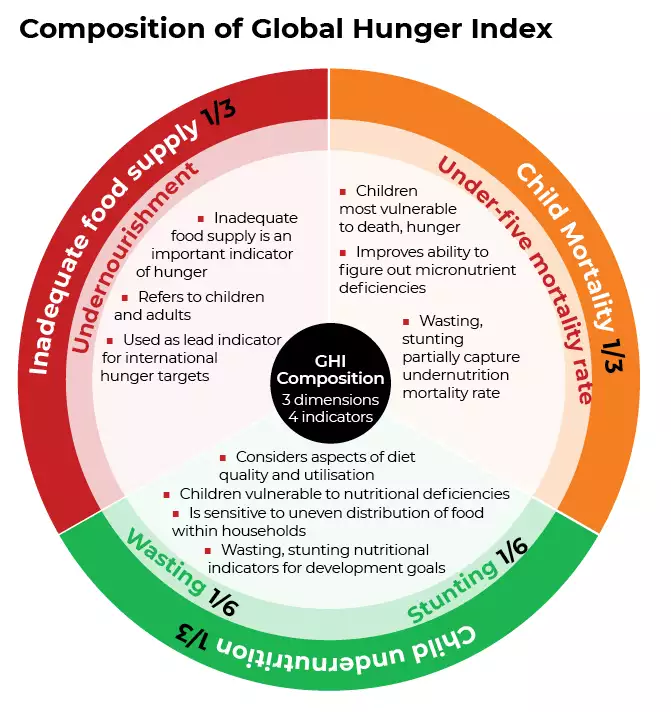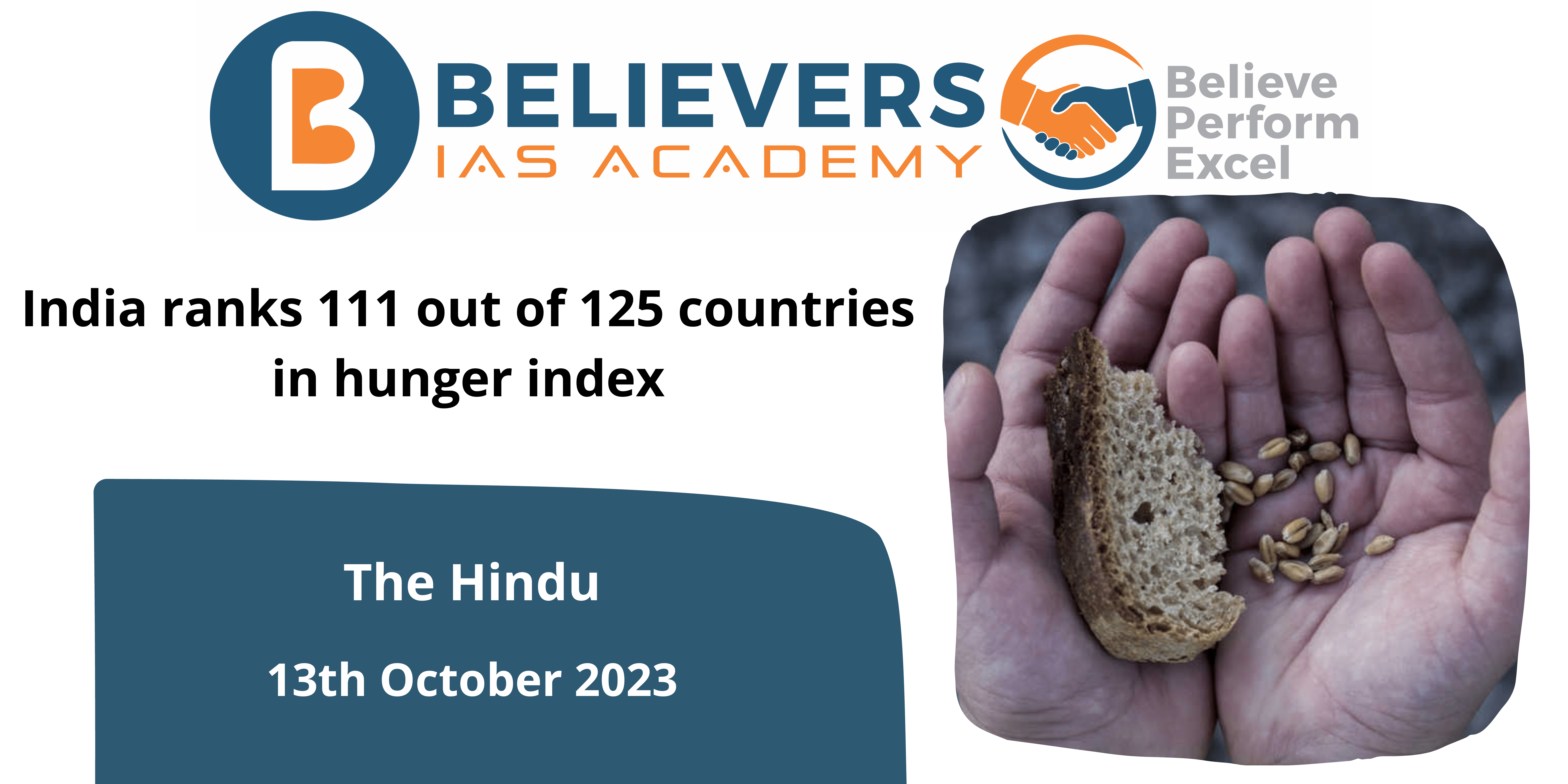India ranks 111 out of 125 countries in hunger index
Context
According to the Global Hunger Index (GHI) 2023, India is ranked 111th out of 125 nations, and its progress against hunger has all but stopped since 2015, which is consistent with a global trend. However, for the third year in a row, the Union government disputed India’s results, pointing to faulty methodology.
What is the Global Hunger Index?
An approach called the Global Hunger Index (GHI) is used to assess and monitor hunger on a global, regional, and national level. It is used to evaluate the extent of hunger and malnutrition in the world and to shed light on the strides achieved in resolving this pressing problem. Every year, the GHI is usually computed and published. The findings are then included in a report that is released, usually in October.
Who is publishing the Global Hunger Index report?
- The GHI was created in 2006 and is prepared by the European non-governmental organizations (NGOs) Welthungerhilfe and Concern Worldwide. The German NGO Welthungerhilfe and the American International Food Policy Research Institute (IFPRI) released it at first.
- Irish nongovernmental organization Concern Worldwide joined as a co-publisher in 2007. After IFPRI left the project in 2018, Concern Worldwide and Welthungerhilfe collaborated on the GHI.
What are the criteria on which the GHI is calculated?

The following are the main factors that go into determining the GHI:
- Undernourishment: The percentage of the population that consumes insufficient calories is shown by this metric. It shows the proportion of the population that does not have access to enough food to meet their energy needs each day. A key component of hunger and malnutrition is undernourishment.
- Child Stunting: A measure of chronic undernutrition, child stunting is the proportion of children under five who are short for their age. One long-term effect of poor nutrition during a child’s formative years is stunted growth.
- Child Wasting: The percentage of children under five who are underweight for their height, a sign of severe malnutrition, is known as child wasting. A more acute and severe kind of malnutrition known as “wasting” is frequently brought on by recent food shortages or illnesses.
- Child Mortality: This measure shows what percentage of kids pass away before turning five. Unhealthy living circumstances and insufficient nutrition have an impact on child mortality. Severe hunger and malnutrition may be indicated by high rates of child mortality.
The Global Hunger Index (GHI) is a 100-point scale that assesses the severity of hunger in a country, considering both chronic and acute aspects. It helps policymakers and organizations address hunger and malnutrition, tracking progress in improving food security and nutritional well-being across regions.
What are the uses of the report in our Country?
- Monitoring Hunger Trends: Every year, the GHI report offers an overview of the national, regional, and worldwide patterns in hunger and malnutrition. It gives interested parties the ability to track changes in these patterns over time, which is vital information for assessing advancements or regressions in the fight against hunger.
- Identifying High-Risk Areas: The report helps humanitarian groups and policymakers focus resources and actions where they are most urgently needed by identifying the nations and regions with the highest rates of hunger and malnutrition.
- Establishing Global Goals: The GHI participates in international talks and goal-setting concerning hunger and malnutrition. It is in line with global endeavours like the Sustainable Development Goals (SDGs), particularly Goal 2, which is to eradicate hunger by the year 2030. The GHI aids in tracking advancement toward these objectives.
- Advocacy and Awareness: The GHI report brings attention to the pressing problem of hunger and malnourishment among the general public. It can raise public awareness of the difficulties experienced by disadvantaged groups and encourage support for resolving these problems.
- Policy Development: When creating and modifying policies about nutrition, food security, and poverty alleviation, policymakers can refer to the GHI report. It offers a fact-based understanding of the origins and effects of hunger.
What is India’s Ranking in the 2023 GHI?
- According to the 2023 study, India ranks 111th out of 125 countries in the GHI.
- India has a hunger severity score of 28.7, meaning that it is classified as “serious.”
- The difficulties India faces in combating hunger and malnutrition are reflected in this ranking.
- On the GHI, Afghanistan, Haiti, and twelve sub-Saharan nations outperformed India.
- For the third year in a row, the Indian government has disputed the country’s GHI results, alleging issues with the methodology.
Conclusion
In order to monitor progress toward international objectives like the Sustainable Development Goal of achieving Zero Hunger by 2030, as well as to increase public awareness of hunger and malnutrition, the Global Hunger Index is a crucial instrument. It also sheds light on the fundamental causes of hunger, including political unrest, the global warming issue, the financial fallout from catastrophes like the COVID-19 outbreak, poverty, inequality, and bad governance.




